by Winding Pathways | Jun 10, 2017 | Birds, Nature, Wonderment
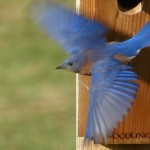
A male bluebird flies from the nest to bring back a snack for its mate.
Here’s a fun guest blog by friends, Gordon and Nancy, about their husbandry of birds on their “Little Acreage.”
“A few years ago my wife and I decided we wanted to attract wildlife to our little acreage. We already had deer and wild turkeys so we decided to try to attract some Bluebirds. We went on line to see where the best spot would be to place some houses to attract them.
“We then went to the Indian Creek Nature Center and bought a couple of houses. We felt that we needed the houses for bluebirds and the Center could use the donation. We placed four houses on the edge of the hay field.
“As time went on, all we saw were sparrows using the nest so we thought nothing would become of our houses. Then, a couple of years ago, a pair of Bluebirds started checking out the nest. But, we never found any eggs.
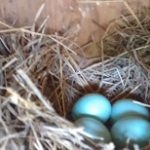
Four eggs! Photo: G&N Bena
“Earlier this year we looked in the house and nothing. A few days later we found these four eggs! What a great surprise for us. We now monitor the nest to watch the progress of our new friends.
Checking the other houses we found that a pair of wrens decided the house was satisfactory for their
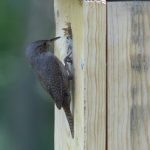
Feeding Young. Photo: G&N Bena
new home and I think they have at least seven eggs. We will be monitoring this nest, also. The other two houses have nests but I think they are sparrow nest. We decided to leave them because they need a home, also.”
Gordon and Nancy
Editor’s Note: Sialis.org has a fascinating set of pictures showing the progression of raising and fledging Bluebird young.
by Winding Pathways | Jun 30, 2016 | Birds, Nature
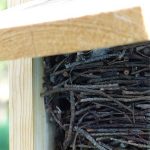
The wrens use just their beak and claws to layer sticks and then feathers from other birds to make a cozy safe nest to raise young.
Just ten days ago the wren parents fledged the babies from the box on our deck. After we knew they were safely gone, Rich unbolted and cleaned out the next. What an amazing feat of engineering! With just a beak and claws, the wrens fashioned a comfy, warm home to sit on eggs and raise young. All was quiet for the rest of the week. The birds had all dispersed.
The past few days we have noticed activity in the High Bush Cranberry, on the deck, around the pond and at the feeders. Today, definite mating activity as up to five wrens competed for attention, displayed mating moves and two began rebuilding the box on the deck. In and out flew the wren gathering small sticks by the pond and placing them in the box. So, it looks like a pair plans to start one more brood.
Later in the year, the Carolina Wren will grace our yard. Larger and more distinctive, it seems to fare well in Iowa even in cold weather.
by Winding Pathways | May 9, 2016 | Birds, Nature
At the end of April house wrens returned to Iowa right on schedule. Every year they seem to appear like magic. Where they were absent just a day or two before the yard suddenly seems to be filled with wren antics and their effervescent voice.
House wrens winter throughout South America and summer across most of North America. Many make their home year round in Mexico.
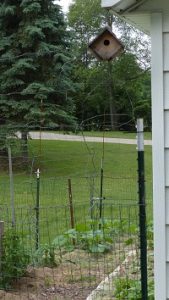
Wrens feast on insects that pillage gardens.
Wrens love suburbia with its diversity of buildings, shrubs, shade trees, and gardens. Soon after arriving in Iowa, a wren pair begins housekeeping. Of all birds house wrens are probably the easiest to lure into a birdhouse. They are not shy. The nest box can be positioned where viewing the emerging family is easy. Wrens also are not fussy. If they can’t find a tree cavity or bird house they’ll move into an old shoe or tin can.
Wrens are tiny birds with enormous appetites. They dine on adult insects, caterpillars, spiders, and many other invertebrates that most people consider pests. A pair nesting near a garden will forage amid vegetables and flowers seeking crop damaging insects.
Perhaps the best wren attributes are their utter cheerfulness and energy. Few wild animals are more fun to watch and listen to. Anyone unfamiliar with the distinctive call of this delightful bird can go to the Cornell Laboratory of Ornithology All About Birds. Type in” house wren” and learn more about this amazing summer Iowan and hear its call.





